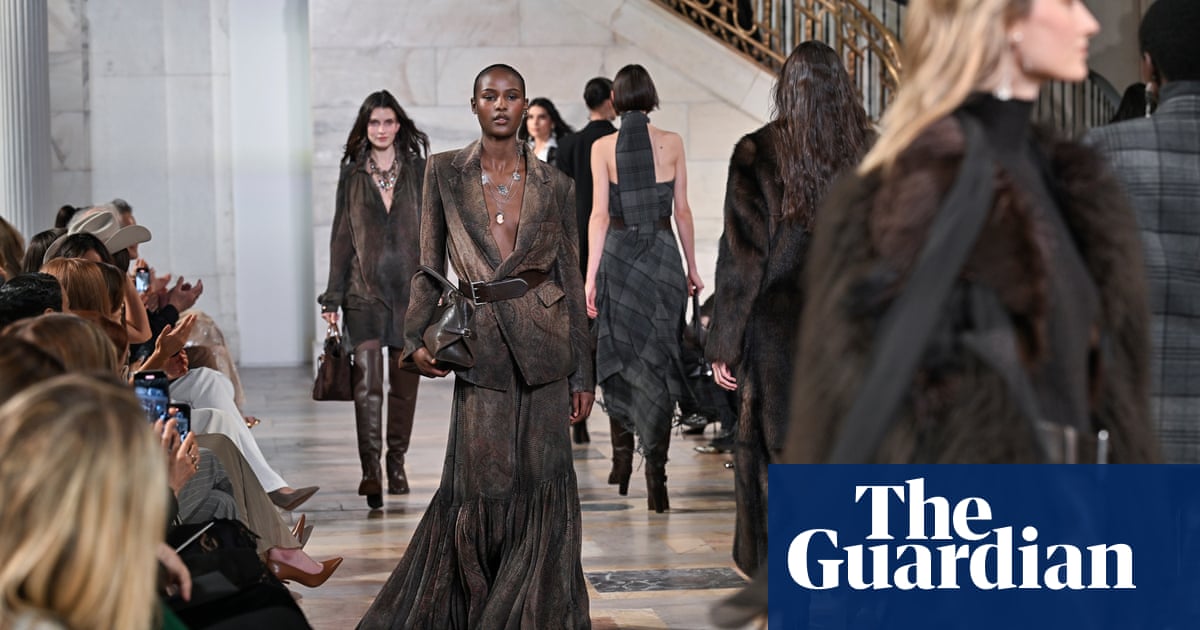Two weeks after Donald Trump announced his “liberation day” tariffs, the fashion industry finds itself in turmoil as it tries to navigate the chaos unleashed.
Some are calling it the “tariffpocalypse”, with the sector bracing itself for a global trade war, snarling up supplies and hiking costs, alongside plummeting consumer confidence.
But on Thursday afternoon inNew YorkCity, it was a case of the show must (literally) go on for Ralph Lauren. The 85-year-old designer unveiled his autumn/winter 2025 collection with a catwalk show staged in the historic Clock Tower building, a gilded wonder just a short hop away from Wall Street.
Guests including the actors Anne Hathaway, Michelle Williams and Naomi Watts were greeted by waiters holding trays of champagne in the building’s former beaux-arts bank hall, complete with Corinthian columns and ornate ceilings.
Although the show had been in the brand’s pipeline for months (Lauren holds his shows off-schedule rather than during the traditional fashion week calendar), the sudden volatility created by Trump’s trade war meant it served as a fashion red herring.
What better way to quell the chatter around fluctuating stocks and waning consumer confidence than with a star-studded front row and clothes such as glamorous evening gowns that looked as if they had been plucked straight from the wardrobes of those living the American dream?
With long-established Asia-centric supply chains, the fashion sector has been left particularly wounded from Trump’s decision to impose duties on finished products. China, most outsourcing is undertaken, faces tariffs of up to245%while Vietnam, another fashion manufacturing hub, faces blanket tariffs of 46% –albeit suspended for 90 days after the president’s abrupt U-turn.
Meanwhile, despite talks with the US, the EU is still grappling to come to a trade compromise. The announcement of “reciprocal tariffs” triggered a sharp decline in shares of Kering, the parent company of Gucci and Saint Laurent, as well as LVMH, whose portfolio includes Dior and Louis Vuitton. Ralph Lauren stock fell by 7%.
Lauren’s show occurred just hours after there was further retrenchment in the luxury sphere. Earlier in the week, the Birkin bag maker Hermès had been expected to overtake LVMH in size but on Thursday it reported 7% year-on-year revenue growth, less than the 8.8% expected. Elsewhere, LVMH’s stock dropped heavily amid disappointing first-quarter results, leading to the chief executive, Bernard Arnault, appearing to attempt to soothe investor fears by announcing the ex-Loewe starJonathan Anderson as the new head of Dior’s menswear.
Sign up toFashion Statement
Style, with substance: what's really trending this week, a roundup of the best fashion journalism and your wardrobe dilemmas solved
after newsletter promotion
With continued confusion on how the tariffs will actually work, brands are unable to accurately ascertain the fallout. Some have been left with no option but to simply wait it out. But perhaps there is opportunity to be found in the interim. While brands cannot control government decisions, they can control the optics surrounding them.
Insiders say the time is ripe for renewed brand positioning that focuses on heritage, craftsmanship and desirability. When prices inevitably rise and houses pass the increased costs on to consumers (Hermès has already said from May its prices in the US will climb), brands that have built an emotional connection with customers may also fare better, especially among aspirational shoppers.
Achim Berg, the founder of FashionSights, a luxury industry thinktank, emphasised the importance of marketing and brand events in times of heightened uncertainty. “Everyone is reviewing what they need to do now. From shows to new store openings, it makes sense given the uncertainty everyone is dealing with.”
With the industry in flux, investors may find comfort in a trusted pair of hands steering the ship. Lauren is one of the last fashion greats still helming the £9.4bn empire he has built. Most recentnet revenue earnings were up 11%. The son of Jewish immigrants, his journey to the top has long been heralded as epitomising the traditional American dream. Under Trump’s tenure, many are questioning if that idea exists any more. However, as Lauren took his bow from the top of an elaborate gold and marble staircase, waving to perfectly coiffed and glossy guests below, it felt very much alive.
